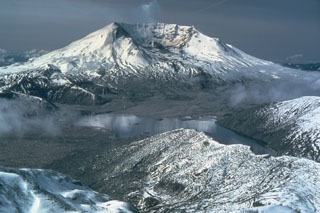Report on St. Helens (United States) — 20 February-26 February 2008
Smithsonian Institution / US Geological Survey
Weekly Volcanic Activity Report, 20 February-26 February 2008
Managing Editor: Sally Sennert.
Please cite this report as:
Global Volcanism Program, 2008. Report on St. Helens (United States) (Sennert, S, ed.). Weekly Volcanic Activity Report, 20 February-26 February 2008. Smithsonian Institution and US Geological Survey.
St. Helens
United States
46.2°N, 122.18°W; summit elev. 2549 m
All times are local (unless otherwise noted)
On 21 February, CVO lowered the Alert Level for Mount St. Helens from Watch to Advisory and the Aviation Color Code from Orange to Yellow. Comparison of photographs taken by remote cameras during late January to mid-February 2008 showed no evidence of extrusion. In addition, very few earthquakes were recorded since late January, gas emissions were barely detectable, and daily ground-tilt events stopped.
Geological Summary. Prior to 1980, Mount St. Helens was a conical volcano sometimes known as the Fujisan of America. During the 1980 eruption the upper 400 m of the summit was removed by slope failure, leaving a 2 x 3.5 km breached crater now partially filled by a lava dome. There have been nine major eruptive periods beginning about 40-50,000 years ago, and it has been the most active volcano in the Cascade Range during the Holocene. Prior to 2,200 years ago, tephra, lava domes, and pyroclastic flows were erupted, forming the older edifice, but few lava flows extended beyond the base of the volcano. The modern edifice consists of basaltic as well as andesitic and dacitic products from summit and flank vents. Eruptions in the 19th century originated from the Goat Rocks area on the N flank, and were witnessed by early settlers.
Source: US Geological Survey Cascades Volcano Observatory (CVO)

